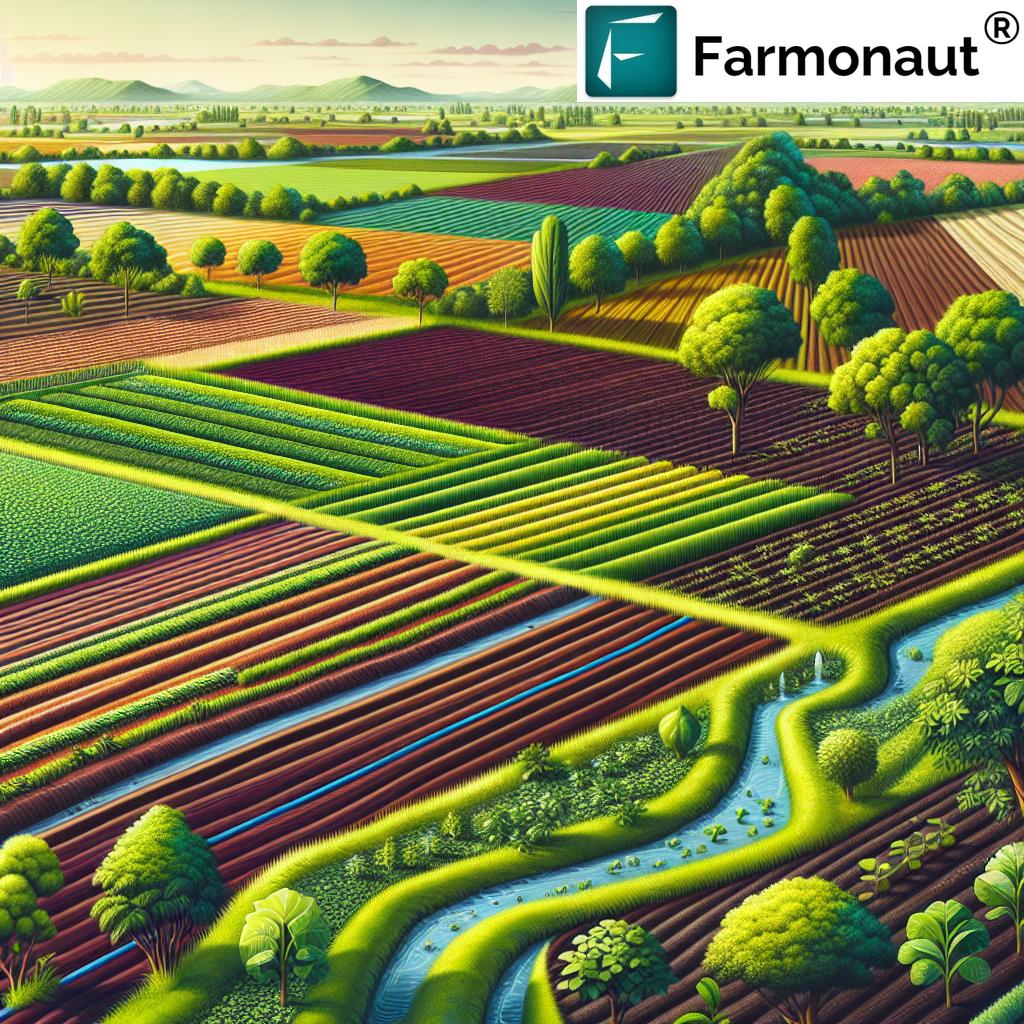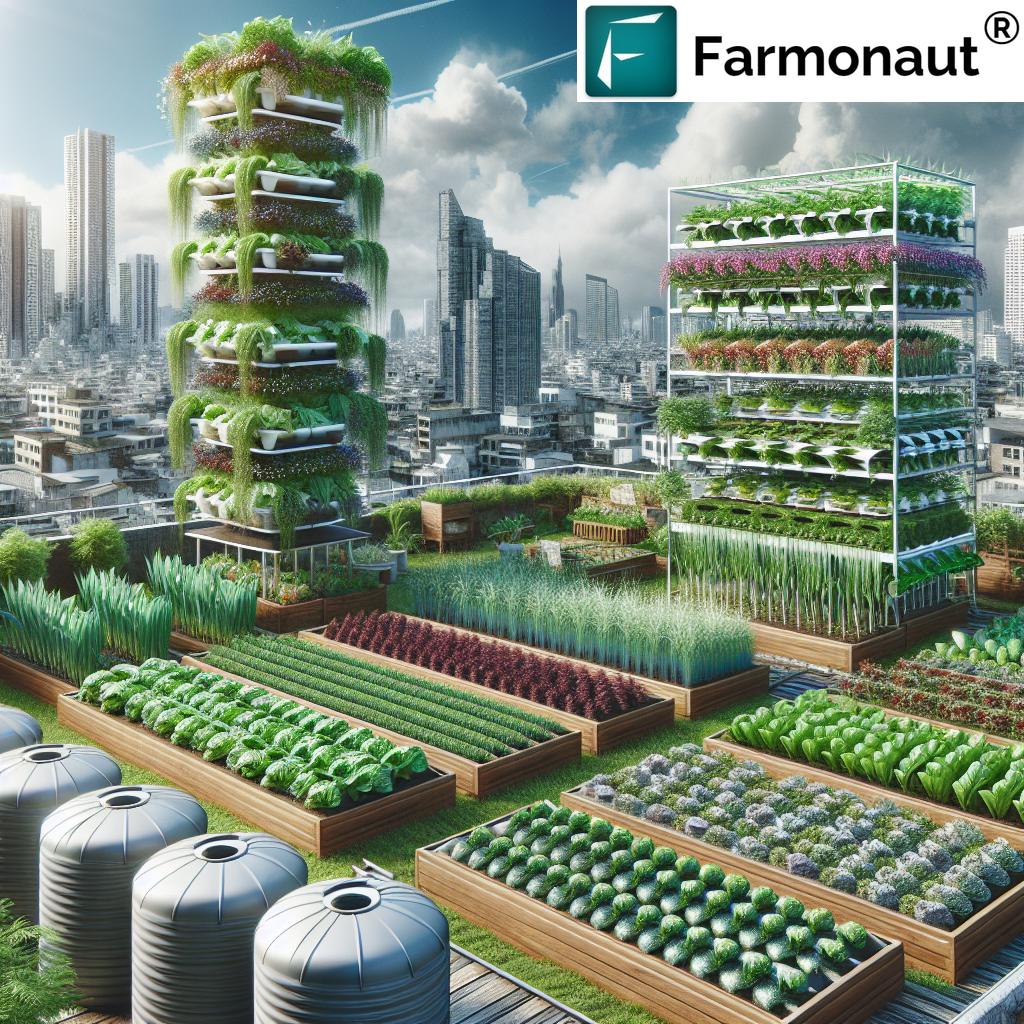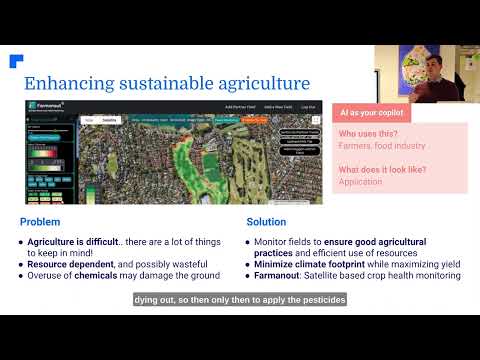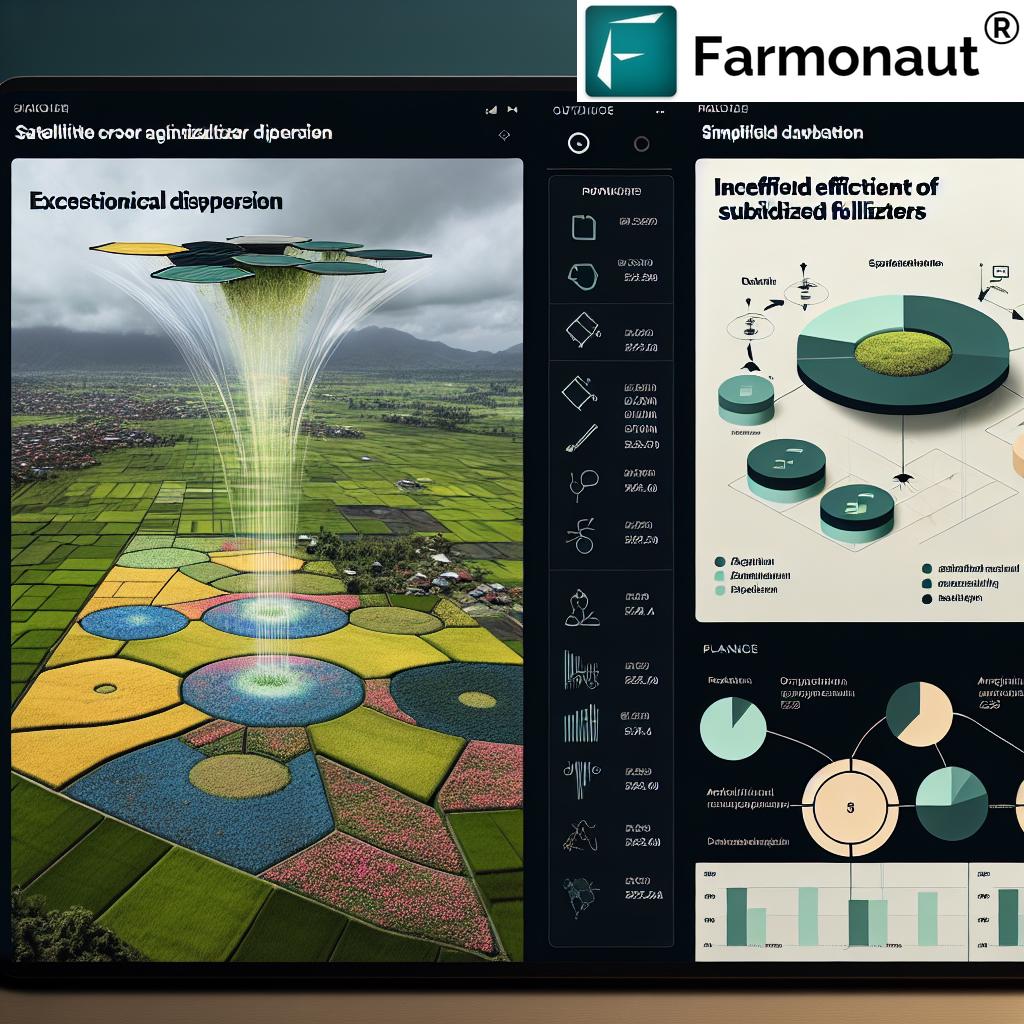Sustainable Farming Methods: 10 Powerful Practices For India
“Crop rotation can increase soil fertility by up to 30% compared to monoculture farming.”
“Sustainable irrigation methods can reduce water usage in Indian farms by nearly 40%.”
- Introduction to Sustainable Farming Methods in India
- The 10 Most Powerful Sustainable Farming Methods
- Comparative Practices and Benefits Table
- Technology Videos: Unlocking the Future of Agriculture
- Farmonaut: Empowering Indian Agriculture with Precision Solutions
- Additional Sustainable Practices for Indian Farms
- Frequently Asked Questions
- Conclusion: Cultivating a Resilient and Sustainable Future
- Farmonaut Subscription & Resources
Introduction to Sustainable Farming Methods in India
In India, where agriculture sustains more than half the population, the adoption of sustainable farming methods is not just an environmental necessity, but a lifeline for ensuring continued food production, soil fertility, water conservation, and rural prosperity. As farmers and stakeholders in India’s vibrant agricultural ecosystem, we are faced with the urgent challenge of increasing productivity while preserving our precious natural resources for future generations.
By adopting practices that work harmoniously with natural ecosystems, we can improve soil health, boost crop yields, conserve water, and reduce our reliance on chemical fertilizers and pesticides. These eco-friendly techniques enhance resilience against climate change, safeguard biodiversity, and promote long-term economic viability.
Let us explore ten powerful sustainable farming methods that are transforming Indian agriculture today.
The 10 Most Powerful Sustainable Farming Methods for India
1. Crop Rotation & Diversity for Soil Health Improvement
Crop rotation is the practice of alternating the types of crops grown in a field across different seasons or years. This disrupts pest and disease cycles, minimizes soil erosion, and brings substantial crop rotation benefits such as enhanced nutrient availability and soil health improvement.
For example, rotating nitrogen-fixing legumes like lentils or chickpeas with cereals (wheat or rice) recharges the soil with nitrogen naturally, drastically reducing our need for synthetic fertilizers.
- Intercropping—growing multiple crops simultaneously—adds another layer of biodiversity, further curbing pest infestations and fostering resilient agricultural ecosystems.
- Such diversity boosts productivity, resilience, and restoration of soil structure, while preserving resources for the future.
2. Cover Cropping: Boosting Soil Fertility and Reducing Erosion
Cover crops such as clover, rye, or mustard are grown during off-season periods. These plants shield the soil from direct sunlight and heavy rains, suppress weeds, and prevent nutrient loss.
- They add vital organic matter, improving soil structure, water infiltration, and nutrient retention.
- In India, cover cropping helps sustain moisture in arid and semi-arid lands, supporting yields even under erratic rainfall patterns.
By **improving soil health** naturally, cover cropping is a foundational step toward sustainable food production in India and beyond.
3. No-Till Farming: Minimizing Soil Disturbance and Enhancing Resilience
No-till farming is a soil conservation technique where crops are planted directly into residue without ploughing or turning the soil. This approach:
- Preserves soil structure and natural microbial ecosystems,
- Reduces erosion by up to 90%, and increases organic matter by 30-40% over conventional farming.
- Decreases water evaporation from the soil and enhances water retention capacity, making crops more drought-resistant.
Furthermore, the method contributes to climate change mitigation by lowering greenhouse gas emissions.
4. Integrated Pest Management (IPM): Reducing Chemical Reliance
Integrated pest management (IPM) combines multiple pest control methods—biological, cultural, physical, and chemical—for sustainable pest management with minimal environmental impact.
Key components include:
- Encouraging natural predators (e.g., ladybugs, ducks in rice fields),
- Using pest-resistant crop varieties,
- Altering planting times and rotating crops to break pest cycles.
By reducing chemical pesticide reliance and enhancing natural authority over pests, IPM protects human health, maintains beneficial species, and promotes lasting agricultural productivity.
5. Agroforestry: Integrating Trees for Improved Agricultural Ecosystems
Agroforestry systems combine crops with trees and shrubs within the same farming landscape. This method:
- Captures carbon efficiently and enhances carbon sequestration.
- Reduces wind and water erosion through natural barriers.
- Supports biodiversity by attracting pollinators, birds, and other useful species.
- Improves microclimates, making farms more resilient to climate change extremes.
For example, Indian coffee estates and fruit orchards benefit from strategically placed shade trees, resulting in better yields and ecosystem health.
6. Organic Farming: Nourishing Land Using Nature’s Principles
Organic farming practices avoid synthetic fertilizers and pesticides, instead leveraging compost, green manure, and traditional techniques like crop rotation and biological pest control. Key benefits include:
- Well-nourished soils, teeming with microbial life,
- Safer produce free from harmful chemicals,
- Reduced water contamination and improved soil fertility over time.
- Improved resilience against drought due to higher organic matter.
Indian consumers’ growing preference for organic food further supports the adoption of this method.
7. Permaculture: Designing Self-Sustaining Agri-Ecosystems
Permaculture is a holistic design approach inspired by natural ecological systems. It involves:
- Planting mixed crops that support each other’s growth,
- Conserving water with swales, mulching, and rainwater harvesting,
- Using compost and natural fertilizers for long-term soil health improvement.
By emphasizing diversity, water conservation in agriculture, and minimal external input, permaculture ensures we can farm profitably and sustainably, even on small plots.
8. Hydroponics and Aquaponics: Innovative Urban Agriculture Solutions
Hydroponics is cultivating plants without soil, using nutrient solutions; aquaponics pairs plant culture with fish farming, where fish waste supplies nutrients.
- These closed-loop systems use up to 90% less water than traditional land-based agriculture—an enormous benefit for water-stressed regions in India.
- They allow farming in urban environments, rooftops, and unused city spaces, increasing food security and reducing logistics costs.
- Hydroponics and aquaponics systems can produce year-round, independent of weather or soil limitations.
By reducing arable land requirements, these methods represent a significant innovation for India’s urban food systems.
9. Water Conservation Techniques: Safeguarding India’s Key Resource
Efficient water conservation in agriculture is critical, given India’s over-extraction and declining groundwater tables. Essential practices include:
- Drip irrigation: Directs water precisely to plant roots, minimizing evaporation and runoff.
- Mulching: Retains soil moisture and suppresses weed growth.
- Rainwater harvesting: Captures and stores rain for use during dry spells.
- Soil health improvement through organic amendments enhances water retention and fertility.
With sustainable water usage, we can significantly bolster agricultural resilience against drought and climate change.
10. Regenerative Agriculture: Restoring Land and Sequestering Carbon
Regenerative agriculture techniques aim not just to sustain, but to improve the land’s health and productivity. They involve:
- Composting and biochar addition,
- Rewilding degraded areas and rotational grazing to simulate natural animal movement,
- Enhancing biodiversity by integrating multiple crop and livestock species.
These practices draw down carbon dioxide from the air, improve soil fertility, boost crop yields, and create more resilient farming systems capable of adapting to future climate shocks.
Comparative Practices and Benefits Table
| Method Name | Description | Estimated Water Savings (%) | Estimated Increase in Soil Health Score | Adoption Potential in India |
|---|---|---|---|---|
| Crop Rotation | Alternating crops across seasons to enhance biodiversity and reduce pests. | 15–20% | +30% | High |
| Cover Cropping | Planting cover crops off-season to prevent erosion and retain nutrients. | 10–15% | +28% | High |
| No-Till Farming | Planting with minimal soil disturbance to conserve moisture and reduce erosion. | 20–25% | +35% | Medium |
| Integrated Pest Management (IPM) | Combining natural and chemical tools for sustainable pest control. | 5–10% | +20% | High |
| Agroforestry | Integrating trees into farming for ecosystem benefits. | 20–30% | +32% | Medium |
| Organic Farming | Utilizing only natural inputs, compost, and biological processes. | 15–20% | +33% | Medium |
| Permaculture | Designing ecological landscapes that mimic nature. | 10–20% | +32% | Low |
| Hydroponics & Aquaponics | Growing crops without soil using water-based nutrient systems. | Up to 90% | +28% | Low–Medium (Urban) |
| Water Conservation Techniques | Drip irrigation, mulching, and rainwater harvesting. | Up to 40% | +24% | High |
| Regenerative Agriculture | Restoring ecosystems via composting, rotational grazing, and biodiversity enhancement. | 25–35% | +40% | Medium |
Technology Videos: Unlocking the Future of Sustainable Agriculture
To support these sustainable methods, technology plays a pivotal role. Discover how innovations are shaping the future of Indian agriculture by watching these selected videos:
Farmonaut: Empowering Indian Agriculture with Precision Solutions
As we continue our journey toward sustainable farming methods, it’s essential for us to make data-driven decisions that maximize resource efficiency, reduce waste, and boost productivity. Farmonaut is dedicated to equipping Indian farmers and agribusinesses with affordable, accessible, and cutting-edge technology for precision agriculture solutions and farm resource management.
- Satellite-based crop health monitoring: Farmonaut’s platform offers real-time multispectral imaging to help us track vegetation health (NDVI), soil moisture, and more. These actionable insights drive optimal irrigation and fertilizer application.
- AI-based Jeevn advisory system: Personalized, real-time advisory for intelligent farm management—ranging from weather forecasts to pest and disease alerts.
-
Blockchain-based product traceability: Complete transparency from farm to fork, building consumer trust and compliance. See how product traceability works for food and textile supply chains:
Learn about Farmonaut Traceability Solutions -
Resource & fleet management: Optimize logistics for farms large and small, saving time, fuel, and money. For more on resource and fleet management, visit
Farmonaut Fleet Management - Carbon footprint tracking: Monitor and lower your climate impact with data-backed strategies: Assess Your Farm’s Carbon Footprint
- Crop Loan & Insurance: Use satellite data for streamlined verification and risk reduction: Get Details on Crop Loan & Insurance Solutions
- Agro-Admin Large-Scale Management: For plantation and government-scale operations, visit Farmonaut Agro-Admin App
By integrating innovative technology into agriculture, we are building a future-ready, environmentally secure, and more profitable Indian farming industry.
“Sustainable irrigation methods can reduce water usage in Indian farms by nearly 40%.”
Additional Sustainable Farming Methods to Enhance Indian Agriculture
While we focused on the 10 most impactful methods, integrating further techniques can amplify our sustainability efforts:
- System of Rice Intensification (SRI): Maximizes rice yields while minimizing seed, water, and fertilizer usage by growing younger seedlings, wider spacing, and optimizing soil conditions.
- Conservation Agriculture: Involves minimal soil tillage, permanent soil cover, and strategic crop rotation to improve water retention and soil fertility.
- Syntropic Farming: Modeling natural forest growth by growing dense, layered crops and trees—building biodiversity and soil nutrient cycles.
- Vertical Farming: Using stacked layers for urban food production with hydroponics, transforming limited land into productive farms.
- Integrated Crop-Livestock Systems: Efficiently cycles nutrients by feeding crop residues to livestock and using manure for fertilization.
- Precision Agriculture: Deployment of GPS, IoT, and data analytics to apply inputs only where they are needed, maximizing output per resource unit. Farmonaut’s precision agriculture solutions are making this technology affordable across India.
- Biodynamic Farming: Treats the farm as a living organism, using cosmic rhythms and natural preparations to foster soil and plant vitality.
- Urban Agriculture Solutions: Rooftop gardens and community farms enhance food security, utilize urban land, and encourage community participation.
- Polyculture: Growing diverse species together to mimic wild ecosystems, reducing risk from pests and climate extremes.
- Sustainable Livestock Management: Methods like rotational grazing protect pastures, promote carbon sequestration, and lower greenhouse gas emissions.
A blended approach—combining these innovative approaches with traditional farming wisdom—will future-proof India’s food supply and environmental heritage.
Frequently Asked Questions (FAQs) About Sustainable Farming in India
- What are the main benefits of adopting sustainable farming methods?
- Sustainable farming methods help improve soil health, reduce water and chemical usage, increase productivity, and ensure ecological balance. They also guarantee long-term profitability and resilience against climate change.
- Which is the most practical practice for small Indian farmers?
- Cropping methods like crop rotation, cover cropping, and drip irrigation are highly practical and offer immediate benefits without high technology investment.
- How does crop rotation benefit soil health?
- Crop rotation prevents nutrient depletion, promotes biological activity, disrupts pest and disease cycles, and can increase soil fertility by up to 30% compared to monoculture farming.
- Are advanced methods like hydroponics and vertical farming suitable for rural India?
- These methods are particularly suitable for urban and peri-urban areas where land is scarce, but open new opportunities for all farmers aiming for space-efficient and water-saving agricultural production.
- Can technology help monitor and support sustainable farming?
- Absolutely! Solutions like Farmonaut’s satellite imaging and AI-powered advisory support precision farming, reduce input wastage, and improve farm decision-making for both large and small-scale producers.
- How do sustainable practices enhance India’s food security?
- By making farms more resilient to pests, diseases, and climate shifts, these methods ensure steady food production and income for farmers, thereby strengthening the nation’s food security.
Conclusion: Cultivating a Resilient and Sustainable Future
The adoption of sustainable farming methods is no longer optional—it is the foundation upon which India’s future food security, rural livelihoods, and environmental health rest. By embracing soil health improvement, water conservation in agriculture, crop rotation benefits, and eco-friendly practices, we empower ourselves and our communities to farm smarter and more sustainably.
Advanced technologies like Farmonaut bring precision agriculture solutions within every farmer’s reach – enhancing productivity, reducing risk, and making our food systems more resilient to climate change.
Let us continue this journey together, adopting sustainable, innovative, and inclusive techniques, for a brighter, greener, and food-secure India.
Are you ready to transform your farm? Explore, monitor, and manage your land with Farmonaut and build a sustainable future for generations to come!
Farmonaut Subscription & Resources
Need personalized recommendations, crop advisory, or access to the best satellite-backed farm management tools? Download the Farmonaut app or access our web platform today.
For advanced crop monitoring, resource optimization, and environmental compliance, check out our latest solutions for:
- Carbon Footprinting – Monitor and reduce your farm’s greenhouse impact
- Product Traceability – Transparent, blockchain-backed food and fiber supply
- Crop Loan & Insurance – Faster, reliable verification for agricultural finance
- Fleet and Resource Management – Optimize farm logistics and machinery usage
- Large-scale Farm Management – Scalable tools for plantations and agri-cooperatives
Let’s build sustainable, productive, and technology-enabled farming systems—together!






















